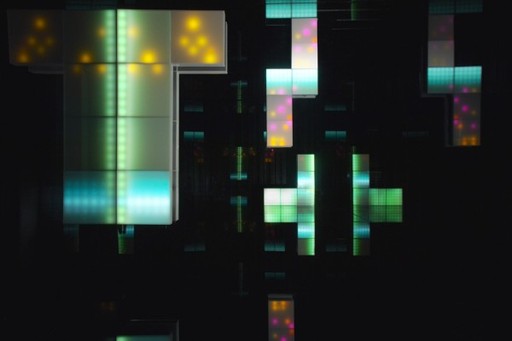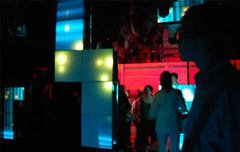-
- Scalable Porosity
- Adaptive Environments
- Kite-powered Design-to-Robotic-Production
- Fibrous Smart Material Topologies
- S.M.A.R.T Environments
- Robotic Building
- METABODY
- --- METABODY 1st EVENT
- --- METABODY 2nd EVENT
- --- Hyperbody update 02-2014
- --- Hyperbody Msc2 prototypes
- --- Ambiguous Topology 07-2014
- --- Reflectego & RoboZoo 07-2014
- --- The Hyper-loop
- --- Nervion, Textrinium & [S]caring-ami 07-2015
- SynSerre
- Robotic Architecture
- Automotive Complex
- Space-Customizer
- InteractiveWall
- iLITE
- Manhal Oasis Masterplan
- Muscle NSA
- protoCITY 2005+
- Virtual Operation Room
- Digital Pavilion
-
-
-
- Projects
- iLITE
- Client
- Philips
- year
- 2007
- Site
- Worldwide
- Lead designers
- Kas Oosterhuis, Ilona Lénárd
- Project architect
- Marthijn Pool
- Design team ONL:
- Marthijn Pool
- Design team Hyperbody:
- Dieter Vandoren, Chris Kievid
-
-

iLITE, a creative vision on architectural lighting solutions
Chris Kievid and Dieter Vandoren
iiLITE installation is designed and developed as a modular system of light objects executed in the interior of the 2.4 m x 2.4 m x 6 m container (Figure 1). Using the versatile Philips Vidiwall modular iTile LED displays, an iLITE multiple lamp object configuration consists of a number of these two-sided tiles sporting a matrix of RGB-led's (Figure 2). The tiles can be fitted to each other on each of the 4 connecting sides, which can also be fitted to the floor, wall and ceiling. When connected, tiles become aware of their position in the network. The real-time generated graphics are mapped over this modular network of tiles, allowing tiles to be added, removed and repositioned in real-time.
[Figure 1] [Figure 2]
Three iLITE configurations were realized for the Transitions series of exhibitions. One configuration stands on the floor, one is cantilevered from the wall and one hangs from the ceiling of the container. Each of them is coupled to an audio speaker. The brainchild of a visionary conceptual strategy, this project creates an endless graphic universe of light that fades out after three or four reflections on the darkened glass surfaces. The visitors experience the feeling of floating in a universe of slowly shifting luminous lines and swarming dots.
The always changing play of straight coloured lines and distributed dots, complemented by tonal and granular audio, is generated by a real-time algorithm specifically written for iLITE using the Max/MSP + Jitter software platform. The movements of people in the space of the container trigger changes in the pattern and the density of the light as well as of the three-channel audio output (Figure 3). All motion is captured by six Phidget motion sensors placed in the ceiling of the container, taking direct input from the behavioural flow of people within the space. The more activity in the container, the more intense the graphic and audio output will be. The visitor is submerged in a responsive environment of light and sound. The public feels its presence matters. When people leave or come to a standstill, the lights will fade out to leave only a few twinkling dots.
[Figure 3]
 Facebook/
Facebook/
 Twitter/
Twitter/
 RSS
RSS

